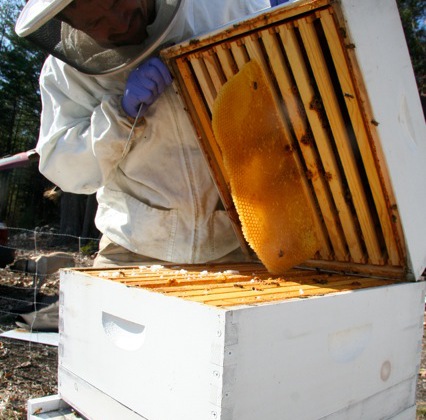Beekeeping in the Northwest Corner
The Secret Lives of Bees…
By Babs Perkins
We’ve all seen them. That stack of boxes at the edge of an open field or meadow or tucked in the corner of an apple orchard. We know that they are beehives, but how many of us actually understand what’s going on inside those mysterious boxes?
Some facts: a bee produces a tenth of a teaspoon of honey over the course of her life, which is somewhere between one and four months. The number of bees in a hive can swell to 60,000 at the height of the growing season and shrink to 7,000 in the depth of winter. Over 95 percent of the bees in a hive are female worker bees, the balance are male drones. There is only one queen. A hive will fly nearly 55,000 miles, visiting over 2 million flowers, to gather one pound of honey. Thirty percent of all our food requires pollination.
Nationally there are three main threats to the bee population: pervasive pesticides, a rural landscape dominated by flowerless cash crops and the spread of parasites like the varroa mite. In the past several decades, the number of crops that depend on bees for pollination has quadrupled while the number of hives available to pollinate them has dropped by half. Though all of this may seem dire, the good news is there are over 500 registered beekeepers in the state of Connecticut, with nearly 3,500 active hives. And even better, that number is on the rise.
One such beekeeper is Colebrook resident Eric Rochow. Rochow has been keeping bees at a nearby farm for about six years. He currently maintains four of the most commonly seen stacked-box type known as the “Langstroth hive.” Named for Yale graduate and onetime congregational minister in Massachusetts, Lorenzo Lorraine Langstroth (considered by many to be the father of modern beekeeping), the hive features several stackable boxes with removable frames on which the bees build their comb for both brood and honey production.
When asked about the way a hive is built, Rochow explained that the bottom-most box is called the “brood super,” which sits on the bottom board. The brood super is usually the deepest of the boxes and is where the queen stays and lays eggs. Above that are the shallower boxes called honey supers. Between them is a queen excluder—basically a board that has holes or slots in it that are large enough for worker bees to go through, but too small for a queen. The main purpose of an excluder is to keep the queen from laying eggs in honey supers, allowing for easier harvesting. There can be one or more of both the brood and honey supers depending on the size of the hive. The entire stack is topped with a hive cover.
Inside each of the supers you will find Langstroth’s main contribution to the hive design that bears his name. Langstroth recognized that bees wouldn’t block up spaces of approximately 1cm so using that knowledge, he created removable rectangular frames that slot vertically into the hive. They fit in such a way the bees won’t attach the frames to each other or to the outer box wall, thereby leaving them free to be removed for inspections, maintenance or harvest without major disruption to hive activities. These frames have a pre-stamped wax foundation built into them, which encourage the bees to create orderly, easily harvestable honeycomb. It’s notable that the cells of the foundation are slightly larger than those bees normally build.
Another local beekeeper Leslie Watkins employs a different style of hive known as the “top-bar hive.” These hives are coffin-shaped and don’t separate the brood and honey production, leaving them up to the natural instincts of the bees. The bars in a top-bar hive have no frame or wax foundation attached, so the bees tend to festoon the bars with natural “u-shaped” comb and build the individual cells to their own inherent specifications.
While there is some good-natured debate as to which hive style is better, the fact remains that any active hives in the neighborhood are a good thing.
If you are interested in attracting more bees to your neighborhood, make sure you have some native species in your garden. Blue or purple flowers tend to draw bees, particularly if grown in clumps. Additionally, herbs—especially those in the mint family—are very attractive to pollinators. This family includes thyme, oregano, sage, basil, peppermint, lavender, catnip and rosemary.
Photo courtesy of Eric Rochow.

